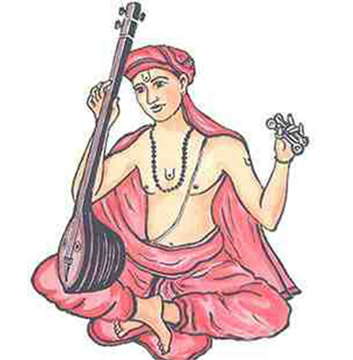Saint Sri Thyagarajaswami
Trinity of Carnatic music - Sri Syama Sastri, Sri Thyagarajaswami and Sri Muttuswami Dikshitar were born in Tiruvarur. Saint Sri Thyagarajaswami was born in Sarvajit, Chaitra, Monday, Sukla Saptami, Pushya in 1759. Kirthana in dramatic composition Prahlada Bhakthi Vijaya “Dorakuna ituvanti seva’ (Raga: Bilahari) depicts his father’s name as Ramabrahma (in the Ankita Charana ‘Ramabrahma thanayudu’) and mother’s name as Sitamma (as mentioned in the kirthana “Sitamma mayamma Sri Ramudu ma thandri” Raga: Vasantha). They were Telugu Vaidika Muriginadu family of Tiruvayyaru.
Their house name (Inti-peru) is Kakarla is known from the one of the kirthana (‘Kakarlambudhi – chandrudu Srikarudagu Thyagaraja’) composed for dramatic composition Naukacharitra.
He was very much influenced by the devotional music compositions of Sri Purandaradasa, Bhadrachala Ramadasa, Kshetragna, Narayana Tirtha and Jayadeva. Sri Sonthi Venkataramayya was the Guru of Sri Thyagaraja. His early composition was “Giriraja suta thanaya” (Raga: Bangala). His compositions were of their poetic excellence and high spiritual value. He was great Bhakta of Sri Ramachandra. He devoted his life to omnipresent Sri Ramachandra and served through divine music Nadopasana. He received a Divine epic “Swararnava” from Sri Narada Maharshi to excellence the sanctity of sacred music. His compositions were an endless epic record with poetic fancies, learned allusions, moral percepts, enunciation of doctrines, high Upanishadic truths, condemnation of sham, hypocrisy and false paths, happy similes, wordly wisdom, popular sayings, and above all every shade and mood of religious, devotional and spiritual experience, renunciation of worldly good and flattery of the rich, prayer, plaintive pleading, yearning, anguish, remonstrance, sportive rebuke, despair and dejection, self-depreciation, faith, hope, exhalation, ecstasy of realization, endearment, joy of service, surrender, dedication and satisfaction.
Sri Thyagaraja composed a series of Utsava-sampradaya—kirtanas and Divya-nama-samkirtanas, two musical plays bringing out greatness of devotion: Prahlada bhakti vijaya and Naukacharitra. His compositions were categorized: 1. Sadhana Sampat (Vairagya; Nitya-Anitya-Viveka; Sama-Dana etc.; Satsanga & Gurubhakti; Kshetra – Tirthatana); 2. Bhakti Yoga (Condemnation of Narastuti, Artha & Kama; Paramartha –Prasamsa) and 3. Nada Yoga (Sangita: Sad-bhakti-Sangita Prasamsa & Sushka-Sangita-garhana)
Pious tradition believes that Saint Sri Thyagaraja composed more than 24,000 kirthans mostly in Telugu and Sanskrit langauages. His songs on glory of Rama to be on par with the 24,000 slokas of Valmiki’s Ramayana. Also Charanam “ Siva manthramuna ‘Ma” jivamu – Madhava manthramuna ‘Ra’ jivamu” of Kirthana “Evarani Nirnainchedira” (Raga: Devamruthavarshini) composed by Sri Thyagaraja indicate that he could be the reincarnation of Maharshi Valmiki.
Saint Sri Thyagaraja recited Rama nama japa for 96 crores in 21 years and had Darshan of Lord Rama four times (Kirthans: Alakalalladaga, Raga: Madhyamavathi; Eela nidayaradu, Raga: Attana; Bhavanutha (Raga: Mohana; Kanugontini, Raga: Bilahari).
Lord Rama informed Saint Sri Thayagaraja when he was almost at the age of 88 years old that he can be granted Salvation as a Sannyasin within ten days (Kirthana “Giripai nelakonna” Raga: Shahana) and attained Brahmibhava on Pushya Bahula Panchami in Prabhava (6th January, 1847).

Reference
The Spiritual Heritage of Tygaraja An Introductory Thesis – Ramanujachari, C. & Dr. Raghavan, V
Krishna Murthy, M. V. 2002. “Rama Bhakti of Sri Thyagaraja”. Published in Sangeeeta Sudha Vol. 1 (1) 2002: 3-4.